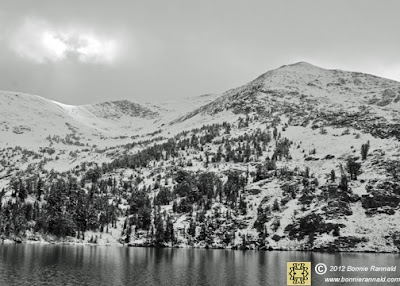Photo Fun When It's Cold Outside
Winter has arrived to the High Desert of Nevada bringing in cold temperatures and other than bundling up, it's a great time to go out and explore nature with the camera. When I mention cold temperatures, I am referring to the freezing point and on down to the single digit range. The further the thermometer drops from the double digits, the harder for me to endure the cold, guess it's my southern blood.
Dressing warmly and in layers goes without saying, but what about the camera. Just like ourselves, the camera body also needs protection from extreme cold. Prolonged exposure when it is very cold quickly drains the life from batteries. In my Nikon D90, I have an auxiliary battery pack that holds two batteries and I always carry an extra battery just incase.
To protect the camera from extreme cold when the air is dry, I wrap it in a neck warmer. When there's rain or snow, a plastic produce bag from the grocery store comes in handy. I place it over the camera with a hole in the end for the lens. Another precaution during cold weather photography is to avoid breathing condensation on the viewfinder.
For protecting my hands, I use Atlas Therma Fit insulated gloves. These gloves are cotton coated with latex rubber on the hand and finger portion,which makes them waterproof. The gloves are thin and very flexible so that I can feel the shutter release and move the command dials on the camera.
After coming in from extremely cold temperatures, be careful about bringing a cold camera in to a very warm area. The sudden warm-up can cause condensation to form in the camera, and this is not good. Leave the camera and lens someplace safe where they can gradually warm up.
So when the mercury takes a dip, layer yourself in warm clothes, bundle the camera up and go explore the frozen world of nature.
What
an exciting and interesting photo-adventure this day has been. I love
it when I am drawn to an area and not knowing what to expect I get
treated to new experiences.
Sign up and follow my blog to see where my next photo-adventure will be!
Photography places me in the moment where I can share that moment in time. It becomes a life story as represented by my interaction with the scene. The happiness and beauty or the sorrow and strife; how I focus leaves a lasting impression that might touch the viewer on a spiritual level.
"Reflecting Nature's Artistry"
No images on this blog are within Public Domain or are available for free download.
All rights reserved, world-wide and images protected by Digital
Millennium Copyright Act (DMCA). All photography, graphics, text,
design, and content is copyrighted by Bonnie Rannald and should not be
copied, down-loaded, transferred and re-created in any way without the
express consent, in writing to Bonnie Rannald.
For information on Bonnie Rannald licensed, right-managed images, please
submit a written request.





























